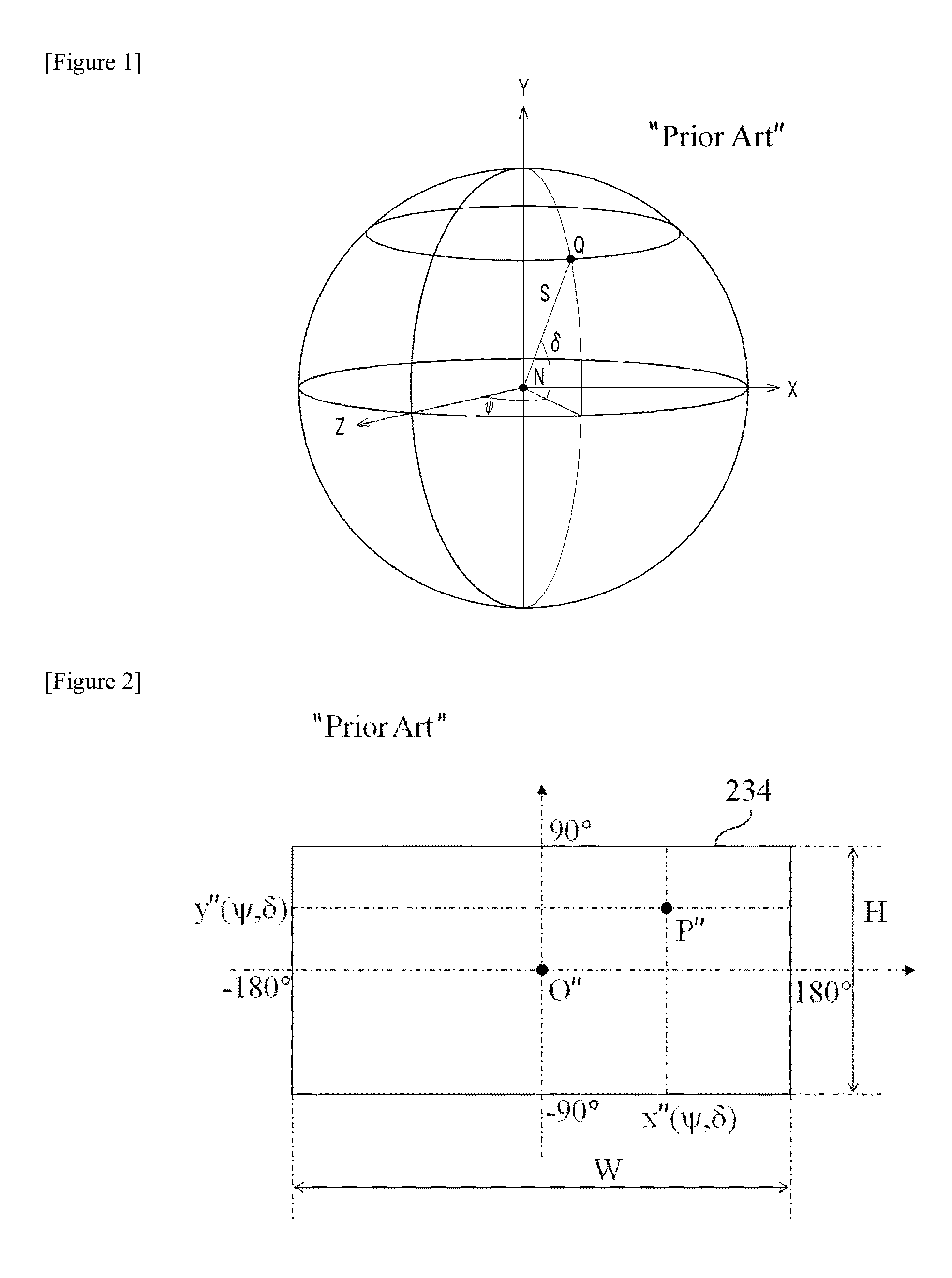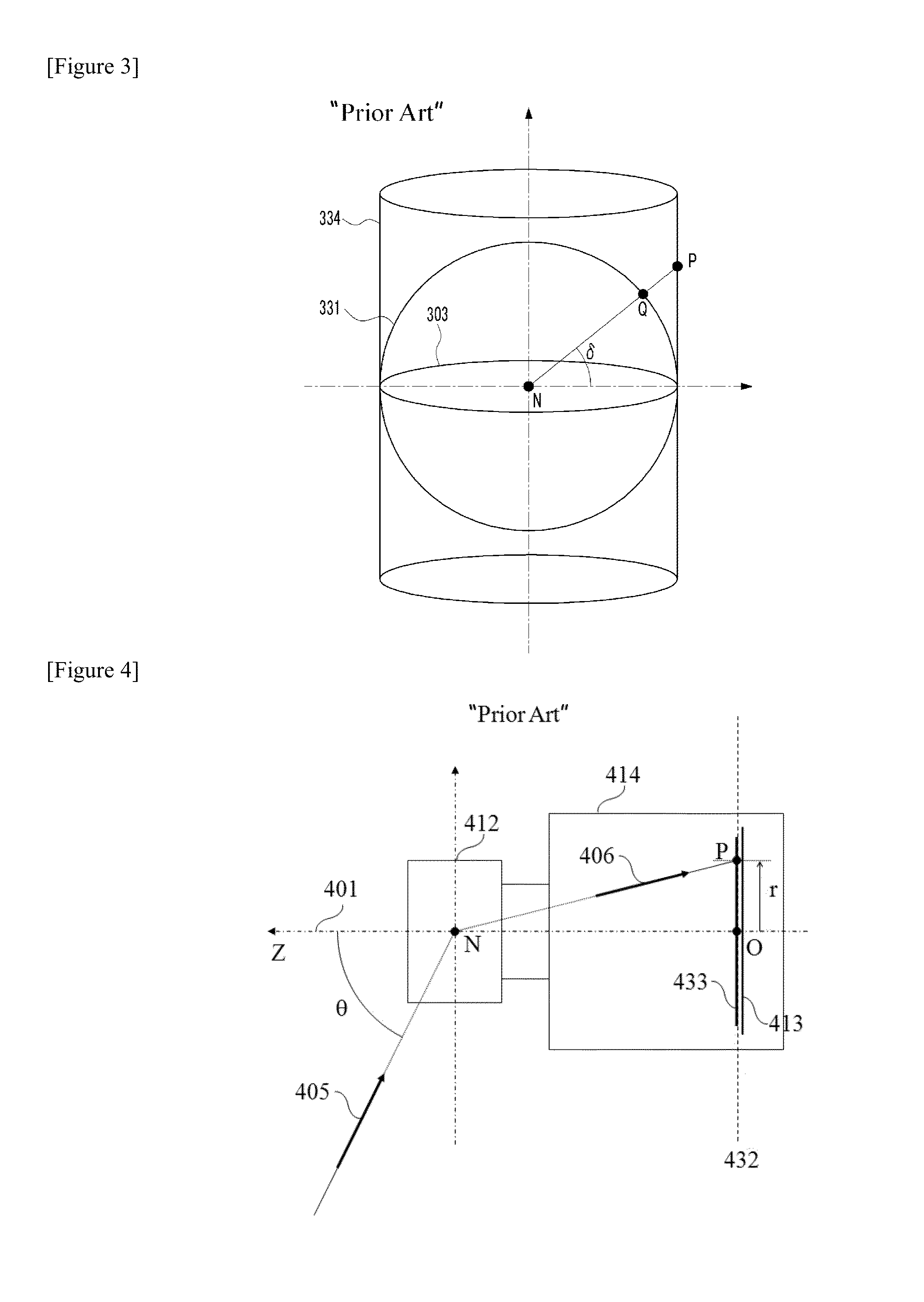Method and apparatus for obtaining panoramic and rectilinear images using rotationally symmetric wide-angle lens
a technology of rotational symmetry and wide-angle lens, which is applied in the field of method and apparatus for obtaining panoramic and rectilinear images using rotational symmetry wide-angle lens, and can solve the problems of dull screen, unsuitable fisheye lens with 180° fov, and wasted pixels
- Summary
- Abstract
- Description
- Claims
- Application Information
AI Technical Summary
Benefits of technology
Problems solved by technology
Method used
Image
Examples
first embodiment
[0168]FIG. 16 is a conceptual drawing illustrating the rectilinear projection scheme of the first embodiment of the present invention. By definition, a lens with a rectilinear projection scheme is a distortion-free lens, and in mathematical viewpoint, the characteristics of a rectilinear lens are considered identical to those of a pinhole camera. To acquire such an image with a rectilinear projection scheme, we assume an object plane(1631) and a processed image plane(1635) in the world coordinate system as shown in FIG. 16.
[0169]The imaging system of the present embodiment is heading in an arbitrary direction, and the third rectangular coordinate system takes the optical axis(1601) of the imaging system as the negative z″-axis, and the nodal point of the lens as the origin. Image sensor plane has a rectangular shape with a lateral width B and a longitudinal height V, and the image sensor plane is a plane perpendicular to the optical axis. On the other hand, the processed image plane...
second embodiment
[0192]FIG. 24 shows one exemplary application wherein such an invention can be used. The built-in camera module is a very important factor in determining the market value of a cellular phone. If a panoramic picture can be taken with a cellular phone(2414), then the customer satisfaction will be greatly increased. Ordinary lens currently mounted in camera phones is comprised of 2˜4 pieces of double aspherical lens elements, and has a mega pixel grade resolution with a typical FOV of 60°. On the other hand, it is possible to realize a fisheye lens with a FOV between 120° and 180° using 3˜5 pieces of double aspherical lens elements. Furthermore, since high end processor such as an ARM core processor is typically embedded in cellular phones, it can handle the image processing load required to embody the conception of the current invention. Therefore, a panoramic camera phone can be realized by installing a wide-angle lens with more than 120° FOV, and endowing the image processing functi...
third embodiment
[0195]If a camera equipped with a fisheye lens with 180° FOV is installed on an interior wall, then practically, there is no dead zone of security monitoring. It is because the region not captured by the camera is the wall that needs not be security-monitored. However, as has been stated previously, an image by a fisheye lens causes psychological discomfort due to its barrel distortion. On the other hand, although an ultra wide-angle image extracted in the manner of the first embodiment of the present invention captures most of the interior scene, captured objects far from the optical axis do not appear natural to the naked eye. In this case, the most natural looking image is a rectilinear image that can be acquired by heading the camera to the direction of the object.
[0196]A camera that can physically provide such an image is a camera equipped with a rectilinear lens and mounted on a pan•tilt stage. Since camera can be oriented to the direction that needs most attention, a most sat...
PUM
 Login to View More
Login to View More Abstract
Description
Claims
Application Information
 Login to View More
Login to View More - R&D
- Intellectual Property
- Life Sciences
- Materials
- Tech Scout
- Unparalleled Data Quality
- Higher Quality Content
- 60% Fewer Hallucinations
Browse by: Latest US Patents, China's latest patents, Technical Efficacy Thesaurus, Application Domain, Technology Topic, Popular Technical Reports.
© 2025 PatSnap. All rights reserved.Legal|Privacy policy|Modern Slavery Act Transparency Statement|Sitemap|About US| Contact US: help@patsnap.com



